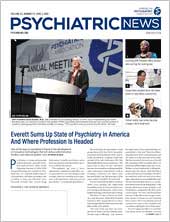How do you talk about gun safety with patients who are gun owners?
It’s a conversation in which physicians have a responsibility to engage, and it requires more than simply asking “Do you have a gun or not?,” said psychiatrist James Curtis West, M.D., at APA’s 2018 Annual Meeting last month in the symposium “Patients and Personal Firearms: Approaches to the Physician-Patient Conversation to Reduce Risk.”
“Firearm ownership is prevalent and increases the risk for death and injury,” West said. “Our obligation is to communicate effective harm-reduction strategies to patients. This is best achieved through culturally competent, evidence-based intervention.”
West is an associate professor and vice chair of the Department of Psychiatry at the Uniformed Services University of the Health Sciences and a scientist in the university’s Center for the Study of Traumatic Stress.
He was joined at the symposium by Matthew Goldenberg, M.D., M.Sc., section chief of Psychiatric Emergency Services at Yale University; Sonya Lewis, M.D., a private practitioner and instructor at the University of Michigan; and Janee Mestrovich, D.O., a psychiatry resident at Walter Reed Army Medical Center.
Goldenberg presented statistics about firearm deaths:
•
Each year in the United States, there are 38,000 firearm-related deaths and 84,000 firearm-related nonfatal injuries.
•
Suicide, the 10th leading cause of death in the United States, accounts for the majority of gun deaths (21,175 in 2013).
•
The majority of suicides (51.5 percent of 41,149) are by firearm.
Lewis discussed the principles of safe gun storage. These include storing the gun unloaded, disassembled or with a properly applied locking device, or locked in a gun safe or secure storage container. Ammunition should be locked and stored separately.
“The four practices of keeping a gun locked and unloaded and storing ammunition locked and in a separate location are each associated with a protective effect and suggest a feasible strategy to reduce these types of injuries in homes with children and teenagers where guns are stored,” she said.
Yet physicians are sometimes reluctant to talk to patients about firearms and how to safely store them, Prominent reasons for not doing so include the following:
•
Belief that the gun ownership is not a problem
•
Sense of helplessness (“there’s nothing I can do to help”)
•
Fear that the subject is too controversial and the patient will get angry
•
“I don’t know enough about firearms”
•
“I don’t know how to have the conversation”
But West emphasized that it is possible—and necessary—to hold a conversation with patients that enables them to move incrementally to safer gun storage practices drawing on the principles of motivational interviewing.
It also requires the clinician to consider his or her own views about gun ownership and how those views may affect the relationship with the patient. “Take a moment to consider your own assumptions about guns and safety,” West said. “Ask the patient about their reasons for keeping firearms and assess their current safety practices.
“If you simply say to a patient, ‘You need to get rid of your gun,’ you may never see that patient again,” West said. “We have a responsibility to care for patients who may not believe what we believe. We need to have a culturally competent discussion built on a relationship with the patient and promoting an open dialogue.” ■

